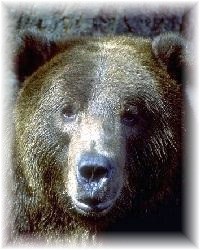
Lara Dale, Steve Gough,
Stacey Burke, and Julia Sherrill
Section 1 - The Grizzly Bear with the Golden Ears by Jean Craighead George pp. 2-17

The Grizzly Bear with the Golden Ears captures
the behaviors of grizzly bears in their natural environment and describes
those behaviors through a story. Golden Ears is the "king and queen"
of bears, as she is described in the book, because she has a cub of her
own and that entitles her to be crowned one of the most feared grizzlies
in the land. Golden Ears, however, is not much of a hunter.
In fact, the only way she is known to obtain food for her and her cub is
by scaring other bears and people out of their catch so that she can appropriate
the food for herself. But she runs into trouble when two dreadful
things happen to her. First, campers and rangers have become fed
up with her bluffing episodes, so they plan to rid their territory of the
lazy grizzly by drugging her and taking her away in the helicopter.
Second, one of the most feared male grizzlies, Ursus, kidnaps Golden Ears'
cub. (It is said that Ursus had been known to kill cubs left unattended.)
As Golden Ears hunts through the forests and over the streams, she is saddened
the more she is away from her baby, but at last they are reunited and safe,
and Golden Ears vows never to return to the dangerous territory from which
she and her cub came.
Discussion Director
The discussion directorís job is to develop questions for the group members to discuss about this section of the book. The focus is on important ideas and issues in this section and designing questions that address them.
Passage Picker
The Passage Picker's job is to select significant passages from the
selections being read; determine why those passages are important; call
other group member's attention to the passage; and lead a discussion about
the passage.
Steps:
1. Pick
out a passage you would like to share.
2. Write
down the page and paragraph number.
3. Write
down the first two words and the last two words of your passage.
4. Write
down the reason you chose the passage, and explain why! (Descriptive,
surprising, it contains figurative language, or it is important)
5. Ask
a question about your passage, and give an answer.
6. Write
down the Authorís Purpose: To Describe, To Entertain, To Inform,
or To Persuade.
Word Wizard
The Word Wizard's job is to search the section being read for words
that are key to understanding what is happening in the story; note the
page and sentence where it can be found; check the dictionary meaning of
the word; lead a discussion about the meaning and intent of the word from
context and what the word contributes to the importance of the passage.
Steps:
1. Write down the word, the page and paragraph
number.
2. Copy the sentence from the book in which
the word appears.
3. Write down the part of speech the word
is in (noun, verb, adjective, or adverb) and what you think the word means.
4. Using the context clues from the sentence
and the dictionary definition, write in your own words the
definition of the word.
5. Tell how this word adds meaning to the
story.
6. Make your Word Wizard card. Be sure
to include in big print, your word and the page and paragraph
number. On the other
side of the card should be a picture, the word, and the definition of the
word.
The Investigator's job is to examine other sources (newspaper, web,
encyclopedia, content texts, etc.) that have connections to the book being
read and share that information with the group.
Character Sketcher
The Character Sketcher's job is to develop a character map of major
characters in the section of text being read.
Steps:
1. Pick out a character that interests you. Choose three
words to describe this character. These should be implied character
traits; that is, they are not directly stated within the text.
2. For each trait, you will give proof (an example) from the
book (write down page and paragraph).
3. Write out the character's goal, problem, and solution (page
and paragraph).
4. Last, you will draw a picture of your character.